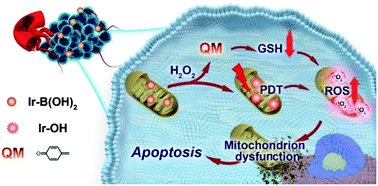A mitochondrial-targeting iridium(iii) complex for H2O2-responsive and oxidative stress amplified two-photon photodynamic therapy†
Abstract
High amounts of glutathione in tumour cells are able to decrease the effectiveness of cancer treatments by capturing the therapeutically necessary reactive oxygen species during the photodynamic therapy (PDT) process. In addition, many photosensitizers for PDT are limited by the light tissue penetration depth, which hinders the application of these compounds to treat deep seated or large tumors. To overcome the aforementioned drawbacks, herein, the use of a mitochondrial-targeting iridium(III) prodrug Ir–B(OH)2 which is responsive to the tumour microenvironment (H2O2 rich) and able to release two-photon photosensitizers (Ir–OH) for PDT and methylquinone as a glutathione scavenger for disrupting the mitochondrial redox homeostasis is presented. Based on the reduction of glutathione, the cancerous cells were more vulnerable to oxidative stress caused by two-photon photodynamic therapy. Upon two-photon laser irradiation (730 nm), a strong and amplified phototoxic effect towards human gastric adenocarcinoma (AGS) cellular and animal models was observed.



 Please wait while we load your content...
Please wait while we load your content...